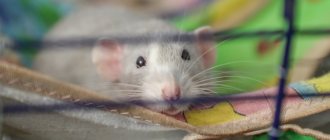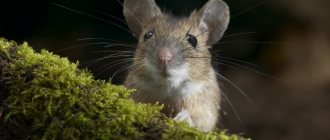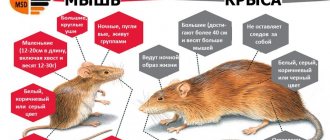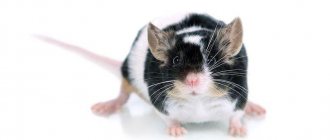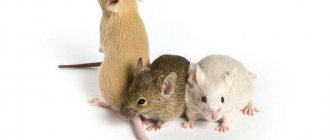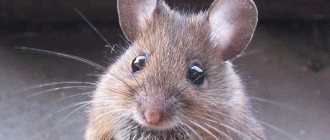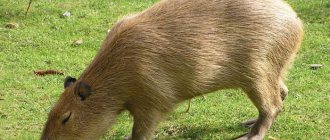Almost every person has acquired a pet at least once in their life. Some prefer common types of pets such as cats and dogs. Some people like exotic reptile species. Well, some owners keep a white mouse as a pet.
has been considered a pet for many years . The origin of these cute animals is controversial. Some sources indicate that the decorative mouse existed before our era. But a more common description of the origin of these mice points to the breeding of ornamental rodent species in laboratories for experiments.
Previously, in many countries there was a belief that if there is a white mouse in the house, it will protect the house from other rodents that can leave the owners without food supplies in a short time. Our ancestors also associated these cute animals with joy. To this day, many people have a favorable attitude towards this decorative animal.
House mice: maintenance and care
Decorative house mice are unpretentious in keeping, do not require much space and quickly adapt to the environment. These small rodents easily get used to humans and become tame, delighting the owner with their unbridled energy. AnyDayLife will tell you how to care for decorative mice. Breeders have bred a lot of interesting varieties of mice, which differ in the type of coat and a wide variety of colors, so everyone can find a pet to their liking. According to the type of hair, mice are standard, long-haired, curly and satin
. Mice are also short-tailed and hairless.
Animals can be monochromatic
. In this case, the mice will be painted in only one color - white, black, red, silver, bluish, etc. There is also a “tan” color.
, when red tan marks stand out against the main background of the mouse.
The fox color
means white tan marks on the background of the main coat color.
Based on the location of the spots, ribbon, Dutch, broken and other marked colors are distinguished. You can also find wild agouti, chinchilla, sable, Siamese and many others.
Conditions and care
Mice are very active rodents and need to move.
. Therefore, choose a spacious enclosure to keep your animal, rather than a small one. A mouse can chew through wood and squeeze into very narrow crevices, so a metal cage with a narrow gap between the bars or a glass terrarium with a wide bottom (at least 40x40 cm)
), the top of the terrarium is covered with a net.
The bottom of the mouse cage should be lined with shavings or cellulose.
, sawdust and peat dust are not suitable for mice. The cage must have a stable feeder, water bowl and house
, where the animal can hide at any time. This could be a box, a jar, a pot, etc. Don’t forget about different devices for games. Levels, ladders, shelters, branches and a running wheel are perfect for mice.
Place the cage for the decorative mouse near the wall, but away from radiators and drafts.
. At first, be prepared for the fact that the mouse will avoid contact with humans and hide in cover. But once the mouse gets used to it, it will greet you with a happy squeak. Make sure that the air temperature in the room where the mouse is kept is about +20ºС without changes, and the humidity should be 50-60%.
It is important to remember that mice are herd animals.
. It is better to choose two or more females for keeping
, since two mice of different sexes will breed up to 11 times a year.
In addition, females will not constantly mark their territory like males. If you purchase one mouse, be prepared to devote much more time to it than to two or more individuals. Otherwise, the animal will get bored and withdraw into itself, constantly hiding in the house. Therefore, play with the mouse more often
, offer it small balls, wooden cubes or figures. Just make sure that there is no paint or varnish on the toys that the mouse could chew off.
When caring for your pet mouse, try to avoid sudden movements.
that will scare the animal. Accustom your mouse to the sounds of your voice by talking to it quietly and gently. Soon the pet will begin to willingly respond to its name. Mice have a very developed sense of smell, so they quickly get used to the smell of the person who brings them food. At the same time, a tame mouse that escapes from its cage becomes wild in just a few days.
Diet of domestic mice
Mice are unpretentious in food; they eat with great pleasure any grains - oats, wheat, millet, barley.
. Sometimes you can give seeds in small quantities, cottage cheese, boiled egg white
.
You can treat your mouse with vegetables, fruits, berries, and bread. Vitamin and mineral supplements
should be added to the mouse's diet once a month . This may be special food from pet stores. In addition, various insects can be introduced into the diet of mice.
Mice have a very fast metabolism, so food must always be in the feeder. Branches of fruit trees are perfect for grinding down incisors.
, however, do not bring any other plants, many of them can be poisonous to the ornamental mouse.
Content
In terms of keeping the mouse, it does not require thorough attention and the selection of special food. Plus, the cost of maintaining these pets is quite low .
This decorative rodent from the white mouse family is very easy to train. Once the mouse gets used to its owner, it will not hesitate to come to its owner's arms. When letting a mouse go for a walk from its cage, it is better to keep an eye on it with both eyes. Because if she hides somewhere, then finding her will be a difficult task.
Wild mice - description and living conditions
Rodent habitat
Mice can be found in every corner of our planet. They live in tropical thickets, coniferous and ordinary forests, steppes and deserts, mountains and swamps. Some types of rodents dig minks, the depth of which can reach 70 cm and the duration of 20 m. Other species of mice make nests in thickets of tall grass, tree roots and stumps.
Mice can dig winter and summer minks, and sometimes occupy abandoned ones. In summer homes, rodents breed, creating for this purpose special bedding from fluff, dry and fresh grass and feathers. Animals store food supplies in winter burrows.
What do rodents eat in the wild?
The basis of the diet of wild mice is plant food. But rodents also love protein foods, so they happily eat worms and insects.
Mice living in the forest feed and store hazel nuts and acorns, maple and beech seeds for the winter, and do not hesitate to eat small beetles and grasshoppers.
Rodents that live near a human home, or right in it, can eat potatoes, bread, meat and other provisions that they find in the house.
How mice behave in their natural habitat
Mice are constantly on the move. This is the basis of their survival, because this is the only way rodents can maintain a comfortable body temperature. In summer, mice are active in the dark, and prefer to rest during the day. They spend the winter underground, so the connection to daylight hours disappears, and activity is smoothly distributed throughout the day. In spring and autumn, mice reproduce, and at the end of summer and throughout the fall they prepare supplies for wintering.
Mice live only in flocks. This makes it easier to arrange a home, raise offspring and search for food. A group of mice is controlled by one leader. Sometimes young males begin to claim his place. Often such actions lead to the collapse of the rodent community.
Reproduction in wild mice
Mice reach puberty 1.5 months after birth. But the readiness to produce the first offspring occurs only at two to three months. Estrus (estrus period) lasts for 9 days in females. At this time, males use ultrasound to attract them. After fertilization, pregnancy occurs, which lasts from 17 to 24 days.
After the mother begins to feed her offspring, a new estrus may come only a month later, when the pups grow up and become independent. After the first birth, the second pregnancy occurs quite quickly, and within a year the female can bear 10-14 litters, each of which will contain 5-10 pups.
Enemies of mice
Mice are hunted by many predators. In the forest, foxes, martens, arctic foxes, ferrets, stoats, weasels, lynxes and even wolves lie in wait for rodents. These animals easily dig up mouse holes and eat up to 30 animals at a time.
Birds of prey also hunt small rodents. The main enemies of mice are owls, buzzards, hawks, eagles, owls and kites.
How long do mice live?
The average lifespan of wild mice is 2-3 years. This is influenced by many factors. For example, the quality of food, the number of predators living in the neighborhood, weather conditions, especially winter cold and summer drought.
Habitats and lifestyle in nature
Mice live on all continents of the globe, except Antarctica. As a rule, they live in deciduous and coniferous forests, steppe zones, mountains, tropical thickets and swampy areas. They also settle in people's houses.
These rodents make nests for themselves. For this they use dry grass stems. The above mammals are capable of creating a complex system of underground passages in order to live in it. They often occupy existing burrows. Species of these animals that live in swamps can swim, unlike those that live in other areas.
Also learn how to tell a mouse from a rat.
In Russia, mice are common. They do not live only in the northern part of Siberia, in the mountain tundras, on Taimyr and near the Lena and Yenisei rivers.
Diseases
It is worth immediately noting that the life expectancy of rats is short - about two years. Under good living conditions, they can live for 4 years. Interesting fact: the maximum age of a rat that has been officially recorded is 7 years. If you keep more than one rat, then quite often fights will arise, which will lead to injuries. They need to be treated.
Sphinx and Dumbo rats are quite susceptible to various diseases, because this is a product of gene mutations, which later negatively affect their health. As a rule, old age for them begins at the age of two years.
Healthy rats are moderately active and inquisitive. They sniff their owner or his hands. If the rodent is too lethargic or, on the contrary, too active, then this indicates that it has health problems
When purchasing a baby rat, you should pay attention to the following points:
- scratches, wounds or sores on the paws and tail; later they can cause other more serious diseases;
- bald spots;
- suppuration on the body;
- frequent sneezing;
- a wet area around the anus is a clear sign of an intestinal disorder;
- any suspicious discharge from the eyes, ears and even nose.
Domestic rats differ from their wild relatives in much poorer health. The former are prone to gaining excess weight and various cancers. To prevent these diseases, it is necessary to carefully monitor your pet’s diet. Separately, it is worth highlighting ticks, lice and other parasites that live on animals covered with hair. To get rid of them, it is necessary to detect the disease in time and treat the animals with special preparations.
Features of life
The life of a mouse The timid nature of a rodent is not at all associated with a cowardly disposition
The small animal is forced to behave carefully, since it has plenty of enemies
A mouse in the wild is trained in various skills - crawling, swimming, digging, and some species even fly. This existence allows rodents to overcome obstacles, adapt to new conditions, and get food everywhere.
The mouse makes its home in the ground, digging out complex labyrinths, in trees, in old hollows, bird nests, and under stones. Once in a person’s house, it settles down under the floor, in the attic, between the walls. Activates activity in the dark. Tries not to go too far from the nest or burrow.
Most species of mice live in packs. A whole hierarchy is built with a male leader and several dominant females. Each individual is assigned a territory where it can obtain food. The Sakis raise their offspring together, but after they “come of age” they are unanimously expelled from the family to live independently.
Mice hibernate in several places:
- in holes deep in the ground;
- haystacks in the field;
- in barns, warehouses, outbuildings, sheds, and a person’s home.
Rodents that remain in the field for the winter prepare food supplies. The hole has several chambers where the mouse carries everything that is valuable to it and will save it from starvation.
Natural enemies of mice are reptiles, wild animals, hedgehogs, large birds, dogs, cats. Since in our area the reptile is not as widespread as in warm countries, predators from this genus are snakes and some species of snakes.
In nature, a living mouse exists for only 1 year. Such a short period is associated with a large number of enemies and natural disasters. The lifespan of mice is genetically determined to be about 5 years. In artificial conditions they can live for about 3 years. In the laboratory they lived until 7.
Types and varieties of mice
Types of mice Mice of different species differ in size, color and habitat. Knowing the characteristics of each species, you can easily distinguish between them.
Little mouse
The smallest rodent in the world. An adult animal fits comfortably in the palm of a child. The body length does not exceed 7 cm, the tail is almost the same. The rodent builds nests from twigs in the grass. The mouse climbs trees well; tenacious paws with sharp claws and a curled tail help it in this. Remains active even in winter and tolerates cold relatively well.
The body color is close to red; it is also called the yellow mouse. The fur on the belly, muzzle, and tips of the ears is almost white. The baby mouse causes damage to garden crops, trees, and crops. Distributed in Yakutia, England, and the Caucasus. The creature is a herbivore, but occasionally eats small bugs and worms.
Wood mouse
The names of mice are often related to their habitat. The wood mouse lives on the edge of the forest. The body length reaches 10 cm, weight 20 g. The tail is about 7 cm. It is characterized by a sharp muzzle, red, brown, even black color. The main difference is the size of the ears. The mouse with big ears became the prototype of the cartoon character Mickey Mouse. Round large ears are a feature of the wood mouse.
The mouse lives in holes or high in the trees. He climbs well and runs fast. It overwinters in a hole located at a depth of about 2 m. In winter, it comes out with the onset of a thaw. It is a harmless creature for humans until it approaches their gardens, orchards, and fields.
Gerbil
The rodent came to our region from the USA. It was brought for laboratory research and quickly spread as a pet. The gerbil does not have an unpleasant mouse odor. It looks like a cute, attractive creature. Has several varieties. The dwarf Mongolian mouse is common in our area. There are about 100 subspecies of gerbil in the world.
The belly is almost white, the back is brownish-red with black hairs. There is a bright black stripe in the center along the back. Small round ears, pink nose, blunt muzzle, larger eyes than other species. The mouse with a tassel on its tail has become one of the most beloved pets.
Steppe mouse
Externally similar to a gerbil. Lives in the fields in the wild. Damages agriculture. Body length is about 7 cm. A distinctive feature is a long tail, which exceeds the body size by 1/3. A mouse with a long tail builds holes in the ground and makes significant reserves for the winter. Loves cereal fields, bushes near ponds and rivers. For prosperous living, as for the wood mouse, a thick grass cover and overgrown shrubs are required. In winter, the field mouse is more active than other relatives. You can often see traces of this mouse in the snow. The same species may be called a vole.
House mouse
The most common rodent. It causes a disgusted attitude, a desire to slam it down, to get rid of it as quickly as possible. With the onset of cold weather, a gray mouse approaches a person’s home. It even climbs into the apartments of multi-storey buildings on the upper floors. Its presence causes a lot of inconvenience, spoils food supplies, chews things, furniture, and interior items. As well as electrical wiring, wires in the car, foam walls.
Body length is about 6 cm. Small round ears, elongated muzzle, tail slightly less than the length of the body. The body color is gray with different shades. It is also called gray-humped. One type of brownie is the black mouse.
White mouse
Occurs in nature in any species of the genus. Due to weak genetic data, the hair fibers acquire a uniform white color. The eyes turn red. Albino mice are more often found within the walls of the laboratory. It was also possible to develop a breed of white mice with normal black eyes but light fur. One of the most common breeds among all pets.
A huge variety of mouse representatives covers all parts of the globe; the origin of the genus goes back to the distant past. A unique animal that man destroys in every possible way, but the mouse remains to live.
White mouse food
In order for the pet to be healthy , the owner should remember that the diet must be balanced. The daily consumption rate is 50 grams of food feed. You can use it as food:
- Cereals.
- Vegetables.
- Curd products.
- Grass is a complete source of minerals necessary for the normal functioning of the rodent’s body.
- If the owner decides to use the seeds as feed, then it should be remembered that they must be raw.
- Fertilized and lactating females need fish oil.
- It is advisable to give your pet some raw meat once a week.
- Under no circumstances should mice be fed sweet, salty or fatty foods.
The dosage of food should be optimal . Although rodents live in peace and harmony and are ready to share food with each other, they should not be limited in food. Also, excessive consumption of food will not benefit them.
To summarize, we can say that these peaceful and active animals do not require excessive care when living as a pet. Periodic change of bedding, arrangement of the house and a balanced diet is all that is needed for the healthy growth of a decorative mouse. If you do not neglect these rules, then a happy animal will, without a doubt, thank its owner with love and curiosity, and will become a best friend who will not only be a pet, but also part of the family.
Sense organs (eyes, ears and teeth)
The bat's eyesight is poor, but its ears can detect the slightest rustle several meters away. The auricle is huge.
Before flying, pushing off from the surface, the animal emits a piercing squeak, which, when it encounters an obstacle, returns. This echolocation allows one to navigate at night and serves as a technique for catching prey.
Eyes of medium size. Set on the front of the muzzle. Vision is black and white. When sunlight appears or imitates it, the bird experiences pain.
The jaw consists of incisors, molars, premolars, and canines. The pungency, shape and quantity depend on the nutrition of the chiropteran creature:
- in insectivores - 38, long, shaped like mortars;
- bloodsuckers have 20–26 teeth, sharp, large on a well-developed jaw.
Reason for choosing a mouse
Decorative pet mice are an ideal option for those who have decided to have their own animal or teach a child to take care of the weak, but are limited by time, funds and square meters.
You can squeeze the mouse
Unlike phlegmatic fish - other inhabitants that do not take up much space - they are able to respond to affection: you can stroke them, feel the warmth of a small body in a fur coat, they are quite affectionate and enjoy sitting in your arms.
Varieties: mouse and mouse are different
Oddly enough, tamed and domesticated mice are divided into only two types. The first species is the albino mouse, also known as the white laboratory mouse. The decorative house mouse is an animal weighing on average 30 grams. with a body 7-12 cm, a tail of the same length, hard, medium-length fur, often one-color: black, brown, gray, sandy color. The lifespan of this miniature animal is on average 2-3 years.
White mouse
The white mouse stands apart - the ancestor of the entire mouse movement. Bred before our era, this creature was a frequent guest in the homes of Chinese emperors, and later, brought to England, quickly won the sympathy of all pet lovers.
In the 19th century, they were attracted to participate in laboratory experiments, as a result of which a separate species appeared - the laboratory mouse. She was bred to participate in laboratory experiments to study social behavior patterns, test medications, and much more that directly benefits humanity. For pet lovers, this species is not so attractive, although albino mice can still be found in city apartments.
Each animal needs its own special space, which it will consider “its place” - sacred and inviolable. Therefore, before you bring mice home, you should take care of where they will live. It was before, not after. Because jars and cardboard boxes are absolutely not suitable for rodents. And any move is always stressful.
Avoid aquariums as well. They are cramped, stuffy, hot, the mouse will not be able to move normally in them and arrange a secluded corner for itself. The best solution would be a spacious cage with metal bars.
Rodent cage
Be sure to make it yourself or buy a small house - a hole where the mouse will spend all day long.
Add a wheel to provide your pet with physical activity and fulfill his need for movement. For the same purpose, take care of shelves, ladders and ropes. The animal will be happy to show you its dexterity, and you will also have fun watching its amusing movements.
Sawdust for rodents
Litter is a very important element. The layer should be quite impressive - at least 5 mm. Animals use it not only for its intended purpose, but also to decorate their house, and when there are drafts or low temperatures, they burrow into it to keep warm.
The material should be natural and preferably inexpensive: sawdust, dry peat crumbs, shavings, hay. Avoid cotton wool and sand - the first absorbs odors too well and gets tangled between your fingers, and the second can become a breeding ground for lice. But something tells us that you don’t want such neighbors.
Setting up a cage for mice
To make your mouse cozy and comfortable, you need to purchase a spacious cage, which can be made from both natural and synthetic materials. The best option would be a rectangular cage with metal bars and a wooden base. The height of the cage is at least 50 cm, and the floor dimensions are 40x40 cm.
This space is enough for one mouse seed to sit comfortably in the cage. To observe the life of your tailed pets, it is best to install transparent houses and tunnels in their home.
The cage must be equipped with a feeder and an automatic drinker. This will allow you to maintain a certain cleanliness in the mouse house, since your pets will knock over food and spill water. It is best to fill the bottom of the cage with fresh sawdust.
If there is only one pet in the cage, then the smell from it will be almost invisible. But when keeping a mouse family, it is best to use a false bottom in the cage. In this case, through small holes on the floor in the cage, feces will be poured onto a special tray, which will allow you not to bother yourself with daily cleaning.
Description of the field mouse
Appearance
Field mice are divided into four species
- Ordinary
- Red
- Lesnaya
- Underground
The species differ from each other in color and small characteristics. But in general they are similar and have a long tail, a pointed muzzle, and small black eyes. The paws of mice are mobile, the length of the foot is about 1.5 cm. The claws are short. The body is covered with thick, coarse hair, with a dark stripe running down the back.
The average weight of a mouse is about 15 grams. Body length is from 10 to 13 cm, not including the host.
Lifestyle of a vole
Voles make their burrows shallow from the surface of the earth. The depth of the burial can be from 5 to 20 cm. The burrow is extensive, with several “rooms” and transitions - labyrinths between them. The labyrinth can be from 5 to 20 meters long. They have several exits, and, as a rule, one of them leads to a water source.
The mouse digs a hole, throwing the earth to the side away from itself, so from the side its house looks like a gentle hill.
During the day, mice are most often found in burrows, and the period of activity begins at night - when they get to the surface, they look for food.
Voles prefer to avoid water, although they are good swimmers.
They settle in small colonies, which consist of a male, 2-3 females and several subsequent generations of individuals.
How long does a vole live?
In the wild, the lifespan of a vole is 1-2 years. Due to the large number of enemies and dangers, they rarely manage to live to old age. But if the mouse’s life goes well, then natural death can occur at the age of 5-7 years.
Range, habitats
The vole, contrary to its name, prefers to settle not in fields, but in places with a lot of grass - in meadows, forest edges, and dense bushes. Mice can build holes for themselves near human habitation. Vegetable gardens, orchards, and agricultural buildings often become their habitat.
Mice live in almost many parts of the world, with the exception of areas with a hot climate and covered with eternal ice.
Widely distributed in:
- Europe
- Mongolia
- Denmark
- Finland
- Korea
In Russia they live in the Urals, Siberia, Primorye, in the northwestern region and in the Moscow region. You can find these rodents on the coast of the Azov and Black Seas.
Natural enemies
The vole has many enemies - small rodents are the main food for predatory mammals and birds. One owl eats about 1,000 voles a year. A ferret is capable of destroying up to 12 individuals per day. Snakes, hedgehogs, foxes and weasels also love to eat mice.
Settling close to a human dwelling, the mouse makes enemies in the form of domestic cats and hunting dogs.
Features of behavior
Rodents move quickly with a “jumping gait.” They can swim, but they rarely use their ability, only when absolutely necessary.
Can use front paws as hands to hold large pieces of food.
They lead a very mobile and active nocturnal lifestyle.
Colors of decorative mice
Mice colors may vary
If you think that decorative mice are all gray or brown without exception, then you are mistaken. Breeders have bred quite interesting varieties of mice, which can differ from each other in the type of their fur (mice can be curly, satin, long-haired or short-haired) and their color. In this case, the colors can be monochromatic - when the rodent is painted in one color, black, white, red, steel, blue... There can be such colors as tan - red, with existing tan markings on the main background, and fox - with white tan markings
When determining the type of color, it is worth taking into account the location of color zones and spots. Depending on this, the type of color can be determined - ribbon, broken marked, Dutch
The colors of decorative mice can also be variegated, when colored specks are located on the main white background.
Also, there are such categories of colors of decorative mice as agouti, chinchilla, sable, Siamese... You can also find completely hairless hairless mice (they look like hairless rats). In any case, you have plenty to choose from...
Rat as a pet: advantages
Many people prefer pet rats as this is an ideal option. Despite the fact that for many people the mere mention of rats causes an ambiguous reaction, when they pick up this cute creature they instantly change their attitude. This is not at all surprising, since decorative and domestic rats are two very different things. As a result of training, these animals are able to master various tricks that make both children and adults admire them.
Caring for a pet is quite simple, since it requires a spacious cage, litter, water and cheap food. If you think of a domestic rat as a dirty and infectious rodent, then this is a huge mistake, since the decorative rodent is considered a very clean animal. If you clean the animal’s cage in a timely manner, then there can be no talk of any smell. The rat itself chooses one of the corners to relieve itself. If for some reason a bowl of food ends up near this place, then the rat drags it with its teeth to a clean place, away from this corner.
This rodent's need for communication is quite high. It is necessary to take into account the fact that each animal, as a separate person, with its own needs and with its own character
It is very important to understand this in time. The domestic rat quickly remembers voices and smells, responding to its name
If you have training skills, you can train your rat to fetch small objects.
This cheerful living creature often plays for hours with children and adults, which lifts the spirits of all family members, forgetting about pressing problems. They feel great in human hands and squeak with pleasure when their belly, back and ears are stroked. These are animals that easily relieve the stress of any person who feels some kind of oppression from work or other everyday worries. Keeping such animals at home gives a person extremely positive emotions, the level of which determines a person’s psycho-emotional state.
Decorative Rat - All about the type of rodent | Type of rodent – Decorative Rat
Watch this video on YouTube
